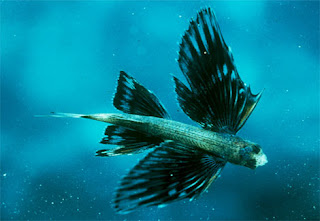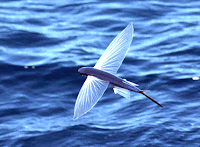Some fish mix in with their grounding, or cluster as one unit to shape vast, tight chunks of writhing forms to getaway from pursuers, but flying fish can very basically vanish from view.
It must be disconcerting for a hunter to discover that the prey it is chasing suddenly disappears. Yet,this is precisely what happens when flying fish are being pursued. When they sense danger, flying fish break through the water surface and put on a burst of speed using lightning-fast beats of their specially adapted tail—it can beat at up to fifty times per
second. Once flying fish reach take-off speed,which can be around 37 miles per hour,they leave the water completely and glide above the surface on their highly modified winglike pectoral (chest) fins.Gliders or Flyers?
To see a shoal of flying fish taking off and gliding over the water surface on a calm day is an unforgettable experience. From a distance,they look more like a flock of seabirds skimming the waves than a shoal of fish. Although we call them flying fish,these fish are gliders rather than flyers.They do not flap their wings inthe waythat animals do when in true flight. Flying fish merely hold their pectoral fins at 90 degrees to their body and glide. The distances covered can be considerable,however. Just how far a flying fish glides depends on the severity of the threat,on wind speed, on the size of the individual,and on the species. The distance can range up to 80 feet in species that have the normal two “wings”and up to 650 feet in those that also possess winglike pelvic (hip) fins.









0 comments:
Post a Comment